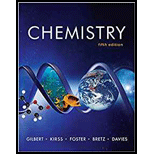
Concept explainers
(a)
Interpretation: A complete and balanced molecular equation and the overall net ionic equations for the given incomplete reactions are to be determined.
Concept introduction: A balanced chemical equation is based on the law of conservation of mass for a closed system. According to this law, the mass of the products formed in a
To determine: The complete and balanced molecular equation and the overall net ionic equations for the given incomplete reaction.
(a)
Answer to Problem 4.77QP
Solution
The balanced equation for the given reaction is,
The net ionic reaction is,
Explanation of Solution
Explanation
The dissociation reaction of
The dissociation reaction of
Therefore, the molecular equation for the reaction between
According to the law of conservation of mass, the mass of the reactants that take part in a chemical reaction is equal to the mass of the products formed in the reaction.
In the given reaction, the number of
The balanced equation for the given reaction is,
According to the solubility rule, group I cations are soluble in the solution.
Therefore,
The net ionic reaction is,
(b)
To determine: The complete and balanced molecular equation and the overall net ionic equations.
(b)
Answer to Problem 4.77QP
Solution
The net ionic reaction is,
Explanation of Solution
Explanation
The dissociation reaction of
The dissociation reaction of
According to the solubility rule, nitrates and ammonia chlorides salts are soluble in the solution.
Therefore, both the salts get soluble after mixing, neither will precipitate out as both are soluble salt.
The net ionic reaction is,
(c)
To determine: The complete and balanced molecular equation and the overall net ionic equations.
(c)
Answer to Problem 4.77QP
Solution
The balanced equation for the given reaction is,
The net ionic reaction is,
Explanation of Solution
Explanation
The dissociation reaction of
The dissociation reaction of
Therefore, the molecular equation for the reaction between
According to the law of conservation of mass, the mass of the reactants that take part in a chemical reaction is equal to the mass of the products formed in the reaction.
In the given reaction, the number of
The balanced equation for the given reaction is,
According to the solubility rule, group
Therefore,
The net ionic reaction is,
(d)
To determine: The complete and balanced molecular equation and the overall net ionic equations.
(d)
Answer to Problem 4.77QP
Solution
The balanced equation for the given reaction is,
The net ionic reaction is,
Explanation of Solution
Explanation
The dissociation reaction of
The dissociation reaction of
Therefore, the molecular equation for the reaction between
According to the law of conservation of mass, the mass of the reactants that take part in a chemical reaction is equal to the mass of the products formed in the reaction.
The above reaction is balanced equation as all the atoms present on reactant and product side is equal
The balanced equation for the given reaction is,
According to the solubility rule, group
Therefore,
The net ionic reaction is,
Conclusion
The balanced equation for the given reaction is,
The net ionic reaction is,
The net ionic reaction is,
The balanced equation for the given reaction is,
The net ionic reaction is,
The balanced equation for the given reaction is,
The net ionic reaction is,
Want to see more full solutions like this?
Chapter 4 Solutions
CHEMISTRY:SCI.IN CONTEXT (CL)-PACKAGE
- What is the final product when D-galactose reacts with hydroxylamine?arrow_forwardIndicate the formula of the product obtained by reacting methyl 5-chloro-5-oxopentanoate with 1 mole of 4-penten-1-ylmagnesium bromide.arrow_forwardIn the two chair conformations of glucose, the most stable is the one with all the OH groups in the equatorial position. Is this correct?arrow_forward
- please help me with my homeworkarrow_forwardhelparrow_forwardThe temperature on a sample of pure X held at 1.25 atm and -54. °C is increased until the sample boils. The temperature is then held constant and the pressure is decreased by 0.42 atm. On the phase diagram below draw a path that shows this set of changes. pressure (atm) 2 0 0 200 400 temperature (K) Xarrow_forward
- QUESTION: Answer Question 5: 'Calculating standard error of regression' STEP 1 by filling in all the empty green boxes *The values are all provided in the photo attached*arrow_forwardpressure (atm) 3 The pressure on a sample of pure X held at 47. °C and 0.88 atm is increased until the sample condenses. The pressure is then held constant and the temperature is decreased by 82. °C. On the phase diagram below draw a path that shows this set of changes. 0 0 200 temperature (K) 400 аarrow_forwarder your payment details | bar xb Home | bartleby x + aleksogi/x/isl.exe/1o u-lgNskr7j8P3jH-1Qs_pBanHhviTCeeBZbufuBYT0Hz7m7D3ZcW81NC1d8Kzb4srFik1OUFhKMUXzhGpw7k1 O States of Matter Sketching a described thermodynamic change on a phase diagram 0/5 The pressure on a sample of pure X held at 47. °C and 0.88 atm is increased until the sample condenses. The pressure is then held constant and the temperature is decreased by 82. °C. On the phase diagram below draw a path that shows this set of changes. pressure (atm) 1 3- 0- 0 200 Explanation Check temperature (K) 400 X Q Search L G 2025 McGraw Hill LLC. All Rights Reserved Terms of Use Privacy Cearrow_forward
 ChemistryChemistryISBN:9781305957404Author:Steven S. Zumdahl, Susan A. Zumdahl, Donald J. DeCostePublisher:Cengage Learning
ChemistryChemistryISBN:9781305957404Author:Steven S. Zumdahl, Susan A. Zumdahl, Donald J. DeCostePublisher:Cengage Learning ChemistryChemistryISBN:9781259911156Author:Raymond Chang Dr., Jason Overby ProfessorPublisher:McGraw-Hill Education
ChemistryChemistryISBN:9781259911156Author:Raymond Chang Dr., Jason Overby ProfessorPublisher:McGraw-Hill Education Principles of Instrumental AnalysisChemistryISBN:9781305577213Author:Douglas A. Skoog, F. James Holler, Stanley R. CrouchPublisher:Cengage Learning
Principles of Instrumental AnalysisChemistryISBN:9781305577213Author:Douglas A. Skoog, F. James Holler, Stanley R. CrouchPublisher:Cengage Learning Organic ChemistryChemistryISBN:9780078021558Author:Janice Gorzynski Smith Dr.Publisher:McGraw-Hill Education
Organic ChemistryChemistryISBN:9780078021558Author:Janice Gorzynski Smith Dr.Publisher:McGraw-Hill Education Chemistry: Principles and ReactionsChemistryISBN:9781305079373Author:William L. Masterton, Cecile N. HurleyPublisher:Cengage Learning
Chemistry: Principles and ReactionsChemistryISBN:9781305079373Author:William L. Masterton, Cecile N. HurleyPublisher:Cengage Learning Elementary Principles of Chemical Processes, Bind...ChemistryISBN:9781118431221Author:Richard M. Felder, Ronald W. Rousseau, Lisa G. BullardPublisher:WILEY
Elementary Principles of Chemical Processes, Bind...ChemistryISBN:9781118431221Author:Richard M. Felder, Ronald W. Rousseau, Lisa G. BullardPublisher:WILEY





